Los Angeles in the 1920s
Los Angeles in the 1920s was a reactionary period. There was a cheap labor movement, a boom in Hollywood's major film studios, as well as an oil boom, and issues of racism to contend with. John Clinton Porter, a former member of the Ku Klux Klan, was elected mayor in 1929. It was a time of economic and demographic change, when the city's population more than doubled in size (from 577,000 in 1920 to over 1.2 million in 1929).[1] In the mid decade, the immigration of Mexican families earned the city the nickname of the "Mexican capital" of the United States, with the Mexican population tripling from 1920 (33,644) to 1930 (97,116).[2]
Extensive modernization took place in 1920s, characterized by the vast sprawl into the suburbs, and the formation of a western business and financial center.[3] Automobile usage in the city increased dramatically.
.tif.jpg)
Overview

In 1919, the community living in the downtown area formed 50% of the population of Los Angeles, and mostly Anglo-Saxon Protestants. Very few people lived in the hills and the suburbs were sparsely populated. As a city, it was ranked 17th in the list of cities in the US with hardly any industrial development, with the petroleum industry in its infancy. However, the only redeeming feature was the Hollywood film industry which dominated the world with its silent movie productions.[4]
A dramatic change took place over the decade, and in 1929, with the Great Depression, the city became a hub of Mexican immigrants and blacks, resulting in some 85 square miles (220 km2) of expansion and encroachment of the San Fernando Valley to its north and to the San Pedro Harbor in the south. The population was a cosmopolitan mixture of Caucasians, Protestants, Blacks (then the second largest group after Baltimore), Jews, Armenians, Italians, and Russians. Internal mass migration also took place when 2 million Americans migrated to California, of which 1.2 million settled in Los Angeles.[5] There were no slums in spite of influx of a large migrant population.[6] The city's population exploded from 102,000 at the turn of the century, to 577,000 in 1920, and over 1.2 million in 1929.
Propelled by the boom, in 1920s, it became the fifth largest city in the US. Petroleum became a major industry with extractions planned from the large reserves of Huntington Beach, Long Beach and Santa Fe Springs. Manufacturing industries boomed and it became the aviation capital of the US and occupied the ninth position among the industrial cities of the country. Eight major Hollywood studios produced 90% of all major movies and also controlled all movie halls and held full film distribution rights.[7] The city also got the nickname of "Emerald City of Los Angeles".[8] Los Angeles Port became the second busiest deep water port and the banking sector became very large. As the emergent economy, fueled by oil and Hollywood real estate boomed, though with a growth fluctuation during 1924-25, one third of the homes in Los Angeles were privately owned by home owners, unlike other major cities in the US where the housing was largely rented.[9]
.jpg)
During the process of development of the city the largest fossil area was found in North America, with prehistoric animals skeletons buried in tar pits (brea in Spanish) (leakage sulphor from the ground), was found during the expansion phase of the city in the 1920. This area located on the Rancho La Brea, which was in the process of development was cordoned off and twelve city block were converted into the La Brea Tar Pits and designated as a county animal fossil area. Over the years more archeological finds were discovered by the Los Angeles County Museum of Natural History. These are prominent exhibits in the museum. The finds on display consisted of mammals, saber-toothed cats, the giant ground sloth, California lion (of more than 1000 lbs), ground stork and golden eagle (800 numbers) and many more of Pleistocene age. Skeleton of only one human that of a woman was found and is on display in the museum under the title La Brea Woman.[10]
In the 1920s, though anti-Semitism persisted, the Jews prospered in Los Angeles, were Americanized and thus Yiddish Los Angeles came to be an established feature, as against the decline of the Chinese establishment. However, China Town remained a gambling den and a red-light area. In contrast, the Japanese presence increased with recorded population of 35,000 Japanese in Los Angeles County by 1930. The American-Mexican population also tripled in the period 1920-30 from 33,644 to 97,116. The rise of the black population during this period was moderate and went up from 15,579 to 38,894.[11]
The famous Hollywood Boulevard was the main road of the Hollywood district of Los Angeles. Sunset Boulevard added to the glamorous age of the Hollywood from the 1920s (continues to this day) and the Hollywood Hills in the backdrop, became the residential complex of the rich and famous of the Hollywood film industry.[12]
1920–21
In 1920, the Architectural Digest started its publications which published pictures of the picturesque gardens that were developed by wealthy settlers. It was also the period when women of Los Angeles took up the study and practice of landscape architecture.[13]

The iconic amphitheater, the Hollywood Bowl was formally opened in 1921 next to the location of the future Hollywood Freeway. [14] It was the venue of music concerts, university graduation ceremonies, and other events of the community. It came to be formally known as the Bowl after 27 March 1921 when its first formal event was the Los Angeles Philharmonic performance, an Easter sunrise service attended by some 800. The first official summer season of the Philharmonic was held here in 1922.[15]
1922–23

In 1922, as per a referendum, a site was identified for locating the Civic Center in the precincts of an area surrounded by the streets of the Main, Broadway, First and Temple in Downtown Los Angeles and for building the Civic Hall, bonds worth US$ 7.5 million were also approved to be issued.[16]
In the 1920s, the Hollywood residential complex, which has the iconic big sign “Hollywood”, was created by the Harry Chandler, the news baron of the Los Angeles Times. [17] The sign was erected in 1923 originally with the name as a billboard of "Hollywood Land Development". In a storm in 1943 most of the board was knocked out and subsequently only the word "Hollywood" was restored.[17]
On 1 January 1923, widely popular evangelist Aimee Semple McPherson, founder of the International Church of the Foursquare Gospel, opened Angelus Temple in the Echo Park neighborhood of Los Angeles. Still in use, the temple was declared a National Historic Landmark some 70 years later.[18]
1924–25
1924-25 witnessed the beautification of street lights with ornamental lights, funds for which were approved by the municipal Art Commission, and later further approved in 1927-28. Torrance, considered a model "industrial suburb", was incorporated into Los Angeles.[19]
.jpg)
In 1925, professional boxing was very popular which was under the new 10 round boxing rules when boxing was an event held every weekday except on Sunday. In 1924 Jack Doyle was instrumental in building the Olympic Auditorium. In this activity he had full support of the Olympic committee for the 1932 Summer Olympic Games taking place in Los Angeles. It was inaugurated on 13 January 1925 when Jack Dempsey, World Heavy Weight Champion and Estelle Taylor film actress were present. The stadium was built with a capacity for 10,400 spectators and was very well equipped. From the beginning of 1925, boxing events were held every alternate week at this venue. The first heavyweight card was also held on 13 January 1925, the 10 round was between Jimmy McLarnin and Fidel LaBarba.[20][21]
1926–27
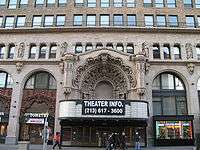
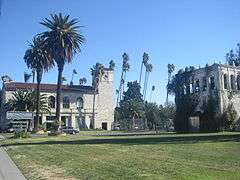
The Hollywood film Ben Hur premiered in December 1925 at the Million Dollar Theater and it ran for six months. The premiere was attended by actors Ramon Navarro, Francis X Bushman, Douglas Fairbanks, Mary Pickford and the director of the film, Fred Niblo. [22] The occasion was a grand affair with a grand orchestra and stage show. [23]
In 1926, famous exotic lover and silent film star Rudolph Valentino died at the age of 31. He is buried in the Hollywood Forever Cemetery, previously called Hollywood Memorial Park. Since then, on the anniversary of his death, a mysterious "Lady in Black" comes to mourn at his grave. [24]
1928–29
_edit1.jpg)
The City Hall, which was authorized to be built in 1922, in place of the old 1888 Romanesque City Hall, became a reality during 1929. This building is a skyscraper built over a colonnaded base, reflecting the power and prestige of the hall.[16]
The premiere of the film The Devil Dancer made by Sam Goldwyn was held in 1928 when the infamous Gilda Gray (who is credited for inventing shimmy) of Poland appeared at the start of the film and made a lot of fuss about the dressing room in the theater.[22]

The Chinese Theater in Los Angeles was opened in 1929 and it became a notable location for holding movie premieres. Here, in the front lobby, the foot prints and hand print impressions are left on cement floor by the famous actors and actresses of movies. This practice was started accidentally when Norma Talmadge stepped on the wet cement here. However, the first formal hand imprints were of Douglas Fairbanks Sr. and Mary Pickford stars of the silent movies.[25] Apart from the cement foot and hand prints of the stars, the theater building has a red pagoda which is 30 ft in height. It was built with financing provided by Sid Grauman and partners and also Mary Pickford and Douglas Fairbanks. However, the bells and other Chinese decorations and artifacts were imported. It was built at a cost of US $ 2 million by Chinese artisans under the guidance of Moon Quon, the Chinese poet and film maker. In 1968, it was listed as an historic and cultural landmark. Cecil B. DeMille's film The King of Kings was premiered here. Befittingly, 85 years later a Chinese TV maker TCL bought this for US 5 million in 2012.[26]
In 1928, to establish a new airport for the city, the Los Angeles City Council selected 640 acres (1.00 sq mi; 260 ha) in the southern part of Westchester. The fields of wheat, barley and lima beans were converted into dirt landing strips without any terminal buildings. It was named Mines Field for William W. Mines, the real estate agent who arranged the deal.[27] The first structure, Hangar No. 1, was erected in 1929 and is listed on the National Register of Historic Places.[28]
Gallery
 Rose Bowl stadium (built 1921-22)
Rose Bowl stadium (built 1921-22) Los Angeles Memorial Coliseum (built 1921-23)
Los Angeles Memorial Coliseum (built 1921-23)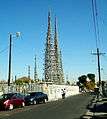 Watts Towers (construction started 1921)
Watts Towers (construction started 1921)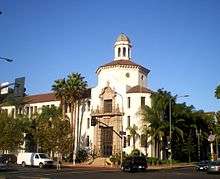 Automobile Club of Southern California (built 1922)
Automobile Club of Southern California (built 1922) Richfield Tower (built 1928-29, demolished 1969)
Richfield Tower (built 1928-29, demolished 1969)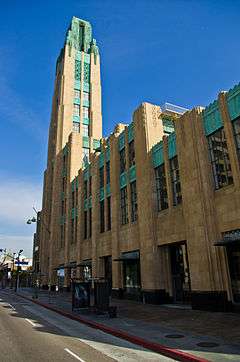 Bullocks Wilshire (built 1929)
Bullocks Wilshire (built 1929) Construction of the Hall of Records, c. 1920
Construction of the Hall of Records, c. 1920- Jardinette Apartments, (built 1927-28)
.jpg) Exterior view of the Southern Pacific Depot, ca.1918
Exterior view of the Southern Pacific Depot, ca.1918
References
- ↑ Gottlieb, Robert (January 2005). The Next Los Angeles: The Struggle for a Livable City. University of California Press. pp. 17–. ISBN 978-0-520-24000-1.
- ↑ Romo, Ricardo (1 January 1983). East Los Angeles: History of a Barrio. University of Texas Press. pp. 80–. ISBN 978-0-292-78771-1.
- ↑ SittonDeverell 2001, p. 2.
- ↑ SittonDeverell 2001, pp. 1-2.
- ↑ Starr 1991, p. 68-69.
- ↑ SittonDeverell 2001, p. 66.
- ↑ SittonDeverell 2001, pp. 2-3.
- ↑ Starr 1991.
- ↑ Starr 1991, p. 70.
- ↑ Starr 1991, p. 76.
- ↑ Starr 1991, pp. 145-148.
- ↑ Dickey 2011, p. 79.
- ↑ GebhardWinter 2003, p. 37.
- ↑ Dickey 2011, p. 98.
- ↑ "From Daisy Dell to the Hollywood Bowl, a Little Musical History for Summer". Kcet.org. Retrieved 18 June 2013.
- 1 2 Starr 1991, p. 112.
- 1 2 Dickey 2011, p. 96.
- ↑ Angelus Temple: Los Angeles, California. The National Park Service website. Accessed 28 February 2014.
- ↑ Becky M. Nicolaides (2 May 2002). My Blue Heaven: Life and Politics in the Working-Class Suburbs of Los Angeles, 1920-1965. University of Chicago Press. pp. 363–. ISBN 978-0-226-58301-3. Retrieved 18 June 2013.
- ↑ Tracy Callis And Chuck Johnston; Tracy Callis (November 2009). Boxing in the Los Angeles Area: 1880-2005. Trafford Publishing. pp. 53–. ISBN 978-1-4269-9064-9. Retrieved 18 June 2013.
- ↑ "Olympic Auditorium History". Los Angeles times. 4 March 1994. Retrieved 18 June 2013.
- 1 2 MacCann 1996, p. 28.
- ↑ MacCann 1996, p. 31.
- ↑ Dickey 2011, p. 94.
- ↑ Dickey 2011, p. 91.
- ↑ "China firm buys naming rights to Grauman's Chinese Theatre". Los Angeles Times. Retrieved 18 June 2013.
- ↑ "LAX Early History". Los Angeles World Airports. Retrieved 18 June 2013.
- ↑ "LAX – Airport Information – General Description – Just the Facts". Lawa.org. Retrieved 18 June 2013.
Bibliography
- Sitton, Tom; Deverell, William Francis (2001). Metropolis in the Making: Los Angeles in the 1920s. University of California Press. p. 2. ISBN 978-0-520-22627-2.
- Kevin Starr (October 1991). Material Dreams: Southern California Through the 1920s. Oxford University Press. ISBN 978-0-19-507260-0.
- Richard Dyer MacCann (1 January 1996). Films of the 1920s. Scarecrow Press Inc. pp. 60–. ISBN 978-0-8108-3256-5.
- Jeff Dickey (1 April 2011). The Rough Guide to Los Angeles & Southern California. Rough Guides. ISBN 978-1-4053-8281-6.
External links
![]() Media related to Los Angeles in the 1920s at Wikimedia Commons
Media related to Los Angeles in the 1920s at Wikimedia Commons